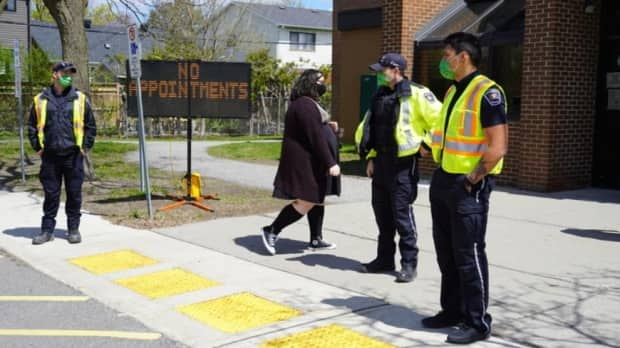The Ottawa area's weekly COVID-19 vaccination checkup: May 13

Highlights:
Ontario has stopped giving first AstraZeneca-Oxford doses.
Provincial rollouts keep expanding by age, job and health conditions.
Children as young as 12 should start getting vaccinated next month.
Ontario's surge of doses to hot spots is ending.
Every Thursday, CBC Ottawa brings you this roundup of COVID-19 vaccination developments throughout the region.
There have been more than 950,000 doses administered in the wider Ottawa-Gatineau region, which has about 2.3 million residents. That's about 115,000 doses more than last Thursday.
Ontario has issued wide vaccination guidelines, but has also given local health units some flexibility. There's more information in the links at the bottom of the page.
The provincial picture
Ontario has stopped giving first doses of the AstraZeneca vaccine — meaning cancelled appointments at pharmacies — for a number of reasons, one being that it's getting more data about the risks of that first dose.
Health Minister Christine Elliot said Monday it is "very likely" that Ontario will need to mix vaccines to get second doses to Ontarians who have already gotten a first shot of the AstraZeneca vaccine — if science and health experts allow it.
The province is also getting a shipment of a quarter million AstraZeneca doses next week to use for second doses.
WATCH | What happens with the AstraZeneca doses on the way?
Ontario has expanded the list of health conditions that qualify an adult for a vaccine to include diseases like diabetes, as well as all cancers. The list of eligible workers has also expanded to include those in the transit, retail, and restaurant sectors.
Health units can lower the vaccination ages for essential workers, but none in eastern Ontario currently say that they are.
Ontario is speeding up a second dose for high-risk frontline health-care workers, dialysis patients and urban Indigenous people.
The province has lowered the overall booking age through the provincial system to 40. It announced Wednesday it plans to offer the Pfizer-BioNTech vaccine to children as young as 12 in June.
Quebec is vaccinating people age 25 and up, moving to age 18 and up Friday. It also plans to get a first dose to children age 12 to 17 in June.
Its vaccine committee is reviewing its AstraZeneca use.
Quebec's economy minister said a vaccine passport could be required for going to work or restaurants.
Prime Minister Justin Trudeau echoed Chief Public Health Officer Dr. Theresa Tam Tuesday by identifying 75 per cent of eligible people getting a first dose as one benchmark for easing restrictions.
WATCH | A Q&A on the strength of a first dose:
Ottawa
A handful of pharmacies in hot-spot postal codes are offering a limited supply of Moderna vaccines to people age 18 and up.
This week's drop-in vaccine clinics are in Nepean's Parkwood Hills neighbourhood, Carlington and the Bayshore area. Targeted information is being released through sources such as the local city councillor and, people will need to show proof they live in the area.

In a Friday memo, city officials said they're exploring the option of a drive-thru vaccine clinic if supply and demand allow.
More than 430,000 doses have now been given to Ottawa residents, including more than 29,000 second doses.
WATCH | A look at an Ottawa door-to-door vaccination program:
Thirty-eight per cent of the city's population has had at least one dose. When you look at just adult residents, it's 47 per cent.
More than a third of residents in their 40s have had a first dose and so have more than 60 per cent of the 50-to-59 age group.
Ottawa's population is about 1,050,000. Some age groups aren't yet eligible for vaccination.
Western Quebec
The Outaouais has distributed more than 190,000 vaccine doses among a population of about 386,000.
Hastings Prince Edward
As the province's surge of doses to hot spots ends this week, there will be more appointments available in Belleville and Trenton over the next two weeks.
More than 68,000 doses have been administered to this area's residents, including more than 4,700 second doses. Thirty-eight per cent of the local population of about 168,000 has now had a first dose.
Tyendinaga has given first doses to nearly 2,400 people and second doses to about 1,700.
Renfrew County
With a population of about 109,000, Renfrew County has distributed more than 42,000 doses. The health unit says 45 per cent of residents age 18 and up have had at least one dose.
Kingston, Frontenac and Lennox & Addington
The region, with a population of about 213,000, has given nearly 90,000 vaccine doses to residents, including about 4,200 second doses.
It's now vaccinated more than 40 per cent of its population, nearly 50 per cent of residents age 16 and up and just over 50 per cent of people age 55 to 59.
Its Napanee community clinic has expanded.
Eastern Ontario Health Unit
Medical Officer of Health Dr. Paul Roumeliotis said late last week the health unit is trying to open more evening and weekend vaccine clinics.
It's warning people of a scam where people ask for money for a vaccine. Shots are free.
Among a population of about 209,000, more than 77,000 vaccine doses have been administered.
His unit wants to reassure people who got their first dose nearly four months ago that appointment spots will be opening up for them and they'll be told when they're available.
Leeds, Grenville and Lanark
Nearly 52,000 of the region's 173,000 residents have received at least one dose, according to the local health unit. That number doesn't include doses administered through pharmacies.

